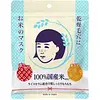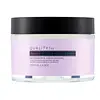What's inside
What's inside
 Key Ingredients
Key Ingredients

 Benefits
Benefits

 Concerns
Concerns

 Ingredients Side-by-side
Ingredients Side-by-side

Water
Skin ConditioningGlycerin
HumectantPropylene Glycol
HumectantAlcohol Denat.
AntimicrobialStyrene/Vp Copolymer
Lactobacillus/Rice Ferment Filtrate
Skin ConditioningOryza Sativa Bran Oil
EmollientHydrolyzed Rice Bran Extract
Skin ConditioningGlycosphingolipids
EmollientGlucosyl Ceramide
Skin ConditioningAlpha-Glucan
HumectantButylene Glycol
HumectantXanthan Gum
EmulsifyingPolysorbate 80
EmulsifyingCitric Acid
BufferingSodium Citrate
BufferingPhenoxyethanol
PreservativeMethylparaben
PreservativeWater, Glycerin, Propylene Glycol, Alcohol Denat., Styrene/Vp Copolymer, Lactobacillus/Rice Ferment Filtrate, Oryza Sativa Bran Oil, Hydrolyzed Rice Bran Extract, Glycosphingolipids, Glucosyl Ceramide, Alpha-Glucan, Butylene Glycol, Xanthan Gum, Polysorbate 80, Citric Acid, Sodium Citrate, Phenoxyethanol, Methylparaben
Water
Skin ConditioningDipropylene Glycol
HumectantGlycerin
HumectantOctyldodecyl Myristate
EmollientDimethicone
EmollientPentylene Glycol
Skin ConditioningPolyacrylamide
Niacinamide
SmoothingCerebrosides
EmollientCeramide NP
Skin ConditioningSqualane
EmollientRetinol
Skin ConditioningRetinyl Palmitate
Skin ConditioningTocopherol
AntioxidantDipotassium Glycyrrhizate
HumectantArgania Spinosa Kernel Oil
EmollientHydrolyzed Sodium Hyaluronate
Skin ConditioningSodium Hyaluronate
HumectantHydrogenated Lecithin
EmulsifyingPhytosterols
Skin ConditioningButylene Glycol
HumectantCentella Asiatica Extract
CleansingScutellaria Baicalensis Root Extract
Astringent(Licorice/Reynoutria Japonica) Root/Stem Extract
AntioxidantGlycyrrhiza Glabra Root Extract
BleachingMelaleuca Alternifolia Leaf Extract
PerfumingRosmarinus Officinalis Leaf Extract
AntimicrobialAnthemis Nobilis Flower Extract
MaskingHydrogenated Polyisobutene
EmollientLaureth-7
EmulsifyingCetearyl Alcohol
EmollientPolysorbate 20
EmulsifyingPolysorbate 60
EmulsifyingXanthan Gum
EmulsifyingHydroxyethylcellulose
Emulsion StabilisingEthylhexylglycerin
Skin ConditioningCitric Acid
BufferingSodium Citrate
BufferingArachis Hypogaea Oil
Skin ConditioningLavandula Angustifolia Oil
MaskingCitrus Limon Peel Oil
MaskingCitrus Aurantifolia Oil
CleansingLemongrass Oil
Rosmarinus Officinalis Leaf Oil
MaskingWater, Dipropylene Glycol, Glycerin, Octyldodecyl Myristate, Dimethicone, Pentylene Glycol, Polyacrylamide, Niacinamide, Cerebrosides, Ceramide NP, Squalane, Retinol, Retinyl Palmitate, Tocopherol, Dipotassium Glycyrrhizate, Argania Spinosa Kernel Oil, Hydrolyzed Sodium Hyaluronate, Sodium Hyaluronate, Hydrogenated Lecithin, Phytosterols, Butylene Glycol, Centella Asiatica Extract, Scutellaria Baicalensis Root Extract, (Licorice/Reynoutria Japonica) Root/Stem Extract, Glycyrrhiza Glabra Root Extract, Melaleuca Alternifolia Leaf Extract, Rosmarinus Officinalis Leaf Extract, Anthemis Nobilis Flower Extract, Hydrogenated Polyisobutene, Laureth-7, Cetearyl Alcohol, Polysorbate 20, Polysorbate 60, Xanthan Gum, Hydroxyethylcellulose, Ethylhexylglycerin, Citric Acid, Sodium Citrate, Arachis Hypogaea Oil, Lavandula Angustifolia Oil, Citrus Limon Peel Oil, Citrus Aurantifolia Oil, Lemongrass Oil, Rosmarinus Officinalis Leaf Oil
 Reviews
Reviews

Ingredients Explained
These ingredients are found in both products.
Ingredients higher up in an ingredient list are typically present in a larger amount.
Butylene Glycol (or BG) is used within cosmetic products for a few different reasons:
Overall, Butylene Glycol is a safe and well-rounded ingredient that works well with other ingredients.
Though this ingredient works well with most skin types, some people with sensitive skin may experience a reaction such as allergic rashes, closed comedones, or itchiness.
Learn more about Butylene GlycolCitric Acid is an alpha hydroxy acid (AHA) naturally found in citrus fruits like oranges, lemons, and limes.
Like other AHAs, citric acid can exfoliate skin by breaking down the bonds that hold dead skin cells together. This helps reveal smoother and brighter skin underneath.
However, this exfoliating effect only happens at high concentrations (20%) which can be hard to find in cosmetic products.
Due to this, citric acid is usually included in small amounts as a pH adjuster. This helps keep products slightly more acidic and compatible with skin's natural pH.
In skincare formulas, citric acid can:
While it can provide some skin benefits, research shows lactic acid and glycolic acid are generally more effective and less irritating exfoliants.
Most citric acid used in skincare today is made by fermenting sugars (usually from molasses). This synthetic version is identical to the natural citrus form but easier to stabilize and use in formulations.
Read more about some other popular AHA's here:
Learn more about Citric AcidGlycerin is already naturally found in your skin. It helps moisturize and protect your skin.
A study from 2016 found glycerin to be more effective as a humectant than AHAs and hyaluronic acid.
As a humectant, it helps the skin stay hydrated by pulling moisture to your skin. The low molecular weight of glycerin allows it to pull moisture into the deeper layers of your skin.
Hydrated skin improves your skin barrier; Your skin barrier helps protect against irritants and bacteria.
Glycerin has also been found to have antimicrobial and antiviral properties. Due to these properties, glycerin is often used in wound and burn treatments.
In cosmetics, glycerin is usually derived from plants such as soybean or palm. However, it can also be sourced from animals, such as tallow or animal fat.
This ingredient is organic, colorless, odorless, and non-toxic.
Glycerin is the name for this ingredient in American English. British English uses Glycerol/Glycerine.
Learn more about GlycerinSodium Citrate is the sodium salts of citric acid. In skincare, it is used to alter pH levels and acts as a preservative.
Its main functions are to maintain the pH of a product and neutralize metal ions.
The acidity of our skin is maintained by our glands and skin biome; normal pH level of skin is slightly acidic (~4.75-5.5).
Being slightly acidic allows our skin to create an "acid mantle". This acid mantle is a thin barrier that protects our skin from bacteria and contaminants.
Learn more about Sodium CitrateWater. It's the most common cosmetic ingredient of all. You'll usually see it at the top of ingredient lists, meaning that it makes up the largest part of the product.
So why is it so popular? Water most often acts as a solvent - this means that it helps dissolve other ingredients into the formulation.
You'll also recognize water as that liquid we all need to stay alive. If you see this, drink a glass of water. Stay hydrated!
Learn more about WaterXanthan gum is used as a stabilizer and thickener within cosmetic products. It helps give products a sticky, thick feeling - preventing them from being too runny.
On the technical side of things, xanthan gum is a polysaccharide - a combination consisting of multiple sugar molecules bonded together.
Xanthan gum is a pretty common and great ingredient. It is a natural, non-toxic, non-irritating ingredient that is also commonly used in food products.
Learn more about Xanthan Gum